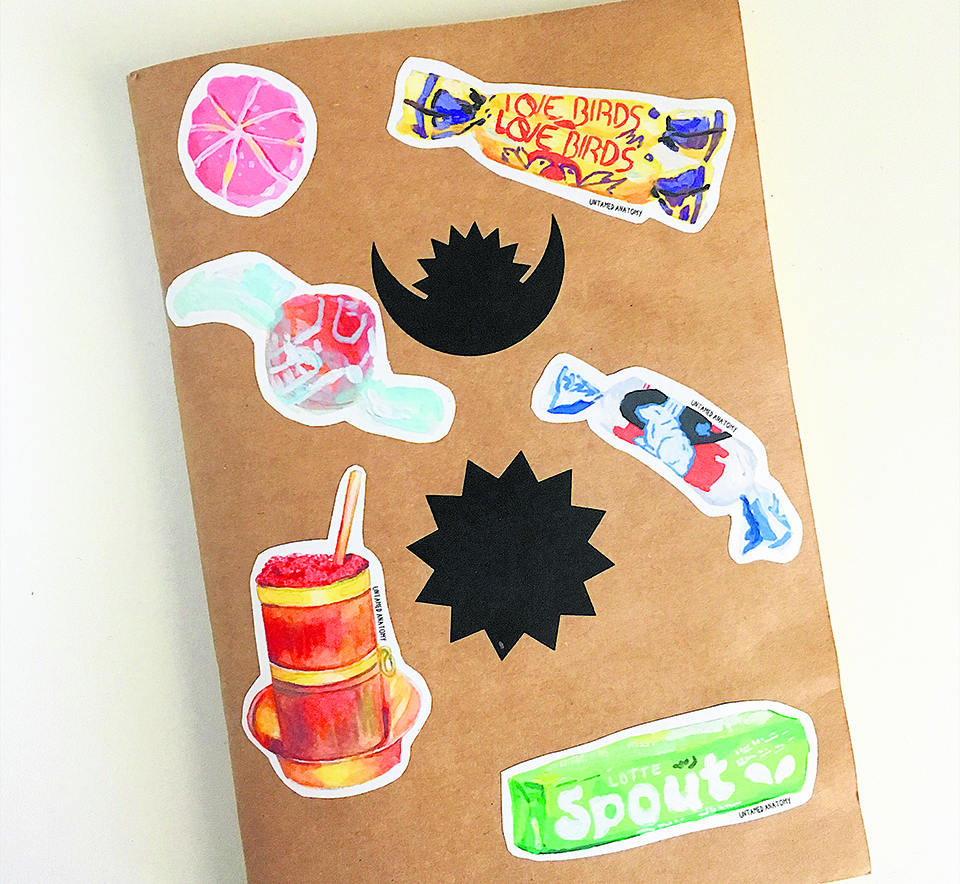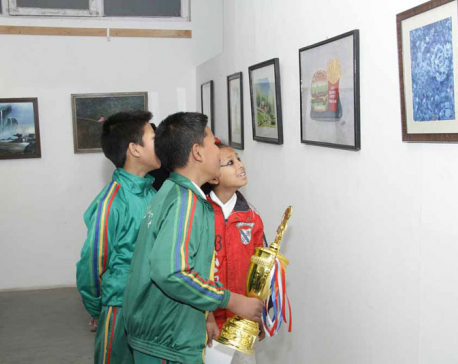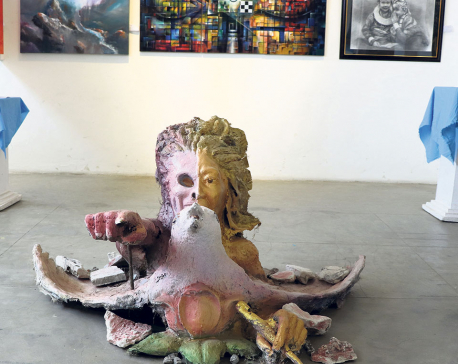
OR

Amidst all the artists who are taking to social media to display their work and gain recognition, illustrator Untamed Anatomy stands out because of her distinctive and relatable take on art. She is a Nepalis illustrator who is based in Queens, New York, and she creates artworks incorporating and highlighting her Nepalis and South Asian heritage. “I create my works honoring the realness of joy, anxiety, frustration and reflective meditation,” says Untamed Anatomy adding that she has always felt that she expresses herself better through art than through words. Here, she talks to The Week’s Anweiti Upadhyay on what art means to her and her journey as an artist.
How did your interest in art develop?
I have been drawing since I was very young. I always knew that I wanted to pursue a career that’s based on creativity in my life but hadn’t narrowed it down to a specific field of art until a few years ago. I graduated with my Arts Management degree and I realized I enjoyed creating artworks the most, and for the past two years I have been creating continuously.
What kind of art do you most identify with? Is there a specific form of art you’re interested in pursuing?
I have tried everything from fine arts to graphic design and after all of that, illustration seems to have grabbed my attention the most. I still love to experiment with different types of art forms including embroidery, upcycling just to keep things interesting. I also have a background in arts management and working in the arts non-profits. I have managed artist for mural projects and worked with art collectives as well. So, even though illustration is my go-to form, my work isn’t limited to just that.
How do you navigate the art world?
I view art as a tool and an outlet to express myself. The most important thing I want to do through my artworks is to tell stories. So, my work always has an element of storytelling within it. I navigate the art world as any artist, trying to find my place but later challenging and questioning that belonging. I love to work independently in terms of management of my works and am not tied to any galleries. I prefer working with communities and finding a common ground. I guess it is about knowing who I am (as an artist) and what I like, dislike and where I stand. I also love sharing my insights of the business of arts with other artists.
Who have been your biggest influences?
The first person to have any level of influence has been my mother. I think she taught me to see things for what they are and value observation and the quality of my work. She was a creative individual who always challenged herself and tried out new things constantly. She baked at a time when the only written recipes you would find were in Indian magazines. I learnt to make handmade crafts from her and she introduced me to Nepali artists and so much more in the field of arts.
I learn and get inspired from creative people who are constantly putting out good work. I also listen to a lot of creative podcasts, and come across so many inspirational creative individuals involved in arts and in things beyond arts through that. My personal favorites are The Creative Pep Talk by Andy. J. Pizza, Design Matters by Debbie Millman and The Unmistakable Creative by Sirini Rao.
What is your working process like?
The starting point of all of my work is with the formation an idea, observation, and vision. I write them down on my phone or my idea book – whenever they come to me. Then I sketch them out and once most of the sketching is done, I transfer or copy it to either a paper or a digital platform, and finish it there. Sometimes, I directly work on the final mediums and that keeps things more raw. The whole process is sometimes finished in a day but other times it takes weeks to complete. Even when I don’t have the exact required materials I need to make my art, I get creative and make do with things available around me.
Is there an artwork you are most proud of?
I did an illustration portrait for my grandma last year. It’s a very emotional piece for me because she passed away almost two years ago. Before that I was producing work too quickly. This work got me to a steady point, grounded me and helped me grieve. I needed an outlet to come to terms with the fact that she was actually gone and creating this particular piece helped me through that.
Any memorable responses you have had from other people regarding your work?
I recently met someone at an art market who deeply related to a work I had recently created. She is a Bengali-Asian American and the piece with a hand with henna holding Thai ice bubble tea resonated with her as she grew up in a very diverse culture. There is a lot of mixing of cultures in NYC. Because I incorporate that into my work, people often comment on how they relate to my work – whether it’s an illustration filled with nostalgia or looking for identity in one’s culture. Once a Nepali, who has been raised in the US, said that she learned the word “prem” (which means love in Nepali) through my art. I also get a lot of fun and memorable messages for my illustrations of food and 90s Nepali candies.
How has moving to New York and sharing your artwork through social media helped you?
My collaborations in New York have been uplifting in terms of finding communities and stories to share. Meeting creative communities and sharing stories are what I love about being an artist so I have been enjoying my time here. As for social media, I’m mostly posting my work on Instagram and the community there is growing steadily. I meet many creative people online, and there is another community that has formed there. Online platform is a tool, it helps document, market, connect, create and sell work. I’ve also recently started uploading content on YouTube and I’m hoping that’ll help me reach out to a bigger community of people.
How do you feel about the art you create?
I have come to respect my journey and be kind to myself. This does not mean I’m not critical, but when I get down to making art, I don’t forget to play around and have fun with my work. Artists are emotional beings. Every art is a step and a process. Momentarily I might not be happy with a piece but looking back, there is always something to take away from the piece. I want to create more with my hand and try to be less dependent on digital media. I’m still exploring and trying out different medias, but it’s a process.
What advice would you give to someone who wants to pursue the arts as their career?
Now is a great time to pursue arts. This industry is ever growing and has a space for everyone who wants to get involved. I would suggest you try looking at arts through a different lens – beyond the starving artist manifesto. Learning and working in this field is a steady process, you can’t rush into it and you have to invest a lot of time. But if you put in the hard work that’s required then it can be very rewarding.


You May Like This

Alfesco Open Art Exhibition begins at Nepal Art Council
KATHMANDU, Feb 14: Alfresco Media and Event organized ‘Alfresco Open Art Exhibition and Competition 2017’ for pre-primary level to college level... Read More...

Heritage in danger
Threats to cultural heritage of Kathmandu Valley can be overcome only with an optimum level of international cooperation, greater public... Read More...

Works of over 400 artists on display at Nepal Art Council
Hundreds of artworks from over 400 artists are being showcased at Nepal Art Council, Babarmahal, Kathmandu in the eighth edition... Read More...




Just In
- Govt receives 1,658 proposals for startup loans; Minimum of 50 points required for eligibility
- Unified Socialist leader Sodari appointed Sudurpaschim CM
- One Nepali dies in UAE flood
- Madhesh Province CM Yadav expands cabinet
- 12-hour OPD service at Damauli Hospital from Thursday
- Lawmaker Dr Sharma provides Rs 2 million to children's hospital
- BFIs' lending to private sector increases by only 4.3 percent to Rs 5.087 trillion in first eight months of current FY
- NEPSE nosedives 19.56 points; daily turnover falls to Rs 2.09 billion















Leave A Comment